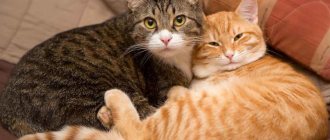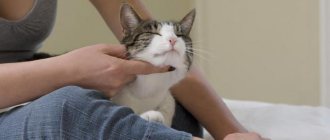There are people who are incorrigible cat lovers, and there are equally incorrigible dog lovers. And between these two groups of animal lovers, disputes often arise about which of the pets is better to have, which of the two pets is kinder, smarter, more affectionate, etc. Such disputes can already be classified as eternal.
And there are people who do not participate in such discussions for the simple reason that they cannot classify themselves as either a dog person or a cat person: they belong to both.
It is about the third type of people, or more precisely about their pets, that we will talk today.
Grooming
Most cats have complex genetic programs for caring for their fur. The average cat can spend up to 50% of its waking time grooming itself or its fellow cats. She uses her rough tongue to lick and comb, and her teeth to remove hard and stubborn dirt. To clean the face and other hard-to-reach places, cats use their front paws moistened with saliva.
Unlike felines, dogs groom and clean only their paws and private parts, and only a few breeds, including Basenjis, Siberian Huskies and a few others, can groom their coats like cats. To keep your dog clean, he will need regular bathing and brushing.
What to do if your dog shows predatory aggression towards your cat
Predatory aggression is a dangerous thing: in this case, the dog can kill the cat. Therefore, it is extremely important to keep both animals safe. What can the owner do in this case?
- Above all, ensure safety. Don't allow your dog and cat to communicate unless you can control the communication.
- Allow the dog to watch the cat in a safe environment. The dog must be on a leash and muzzle, and it is better if there is a barrier between it and the cat (for example, a children's fence).
- Choose a distance at which the dog can look at the cat without lunging at it. If the dog cannot control itself, increase the distance.
- Praise your dog when he turns away from the cat.
- Reduce the distance very gradually.
- Start walking around the room. Vary the distance until you understand how far the dog can pass the cat without reacting. Reinforce this behavior and gradually reduce the distance.
- Allow a muzzled dog to sniff the cat, but only if the dog is calm.
- Hold or leash the dog and allow the cat to roam around the room. Reinforce your dog's calm behavior.
- If the dog reacts calmly to the cat every time, you can let him go and let them be in the room together in your presence.
- Be sure to monitor the behavior and body language of both animals, notice the slightest signs of excitement and stop communicating. Don't let negative experiences form.
Keep in mind that this type of aggression in a dog can take a very long time (sometimes years), so you will have to be patient.
Photo: commons.wikimedia.org
Toilet
Both cats and dogs have their own very specific toileting habits. Cats prefer privacy when doing their business, whether they do it indoors or outdoors, and tend to bury their feces in sand or litter. Cats that live exclusively in indoor environments are especially fussy and anxious about the cleanliness of their litter box, and often even refuse to share it with another cat. Dogs, however, very rarely worry about toilet space, although they usually prefer grass to hard surfaces.
The first meeting of a cat and a dog
When meeting pets for the first time, patience is important. It is necessary to keep them not together, but in different rooms, until the pets get used to each other’s smell. At the same time, if there is an older dog in the house, regardless of purebred or stray, they begin to work with him, give him treats, if on the street he does not rush after the yard cats. Be sure to teach the dog basic commands.
First acquaintance plays an important role
In relation to a pair of an older cat and a small puppy, it will not be possible to teach the former to do this. Although, according to statistics, it will be easier for them to make friends, since cats perceive a new companion less aggressively.
For your information! After a few days, I can meet the cat and puppy in reality, so to speak for real. It is important to allocate a large room for this, and until the animals have sniffed each other, do not leave them alone for now.
It is important not to rush the animals, as the grinding process is not quick. You should not push the cat or dog towards each other; acquaintance should happen naturally. Often, a dog can show maximum emotions, lack of restraint regarding the first acquaintance with a cat, the latter can hiss and attack. Therefore, you should distract the dog and work on controlling its activity in the future.
Dog smells
Dogs are unable to groom themselves the way cats can, so their dying skin cells or dandruff along with their hair loss release a lot of odors. In addition, a dog's skin produces oils that are carried through sweat and which carry additional chemical odors. Another subtle dog odor is the smell of the glands that are located inside the ears. Together these smells combine, mix and give the dog his usual normal "doggy" smell. If the animal has an ear or skin infection, this can make the smell much stronger. Regular brushing and bathing will help minimize this odor.
Options for making friends between a cat and a dog
How to make friends between a cat and a kitten: ways to reconcile pets
How to make friends between a cat and a dog depends a lot on who moved into the house first, who is older.
Cat and puppy
How to make friends between an adult cat and a small puppy - this option is less successful for the owner of animals, since some cats are too capricious and consider puppies or small, decorative dogs too shameless. How to make friends and reconcile an adult cat and a small, homeless or purebred puppy? Take into account a number of rules.
- If the dog is an adult, the owner must take into account the degree of aggressiveness of the pet. He should not regard the cat as a hunting object. If the dog is a hunting breed, it will not be possible to reconcile the neighbors, since the desire to chase game is at the level of instincts.
- It is optimal if the dog has had a positive experience with cats and accepts his mustachioed friend at home and on the street without aggression.
- If the dog is a large breed, then before meeting the cat you need to tire him out with play, exhaust him with commands, and run around. This way the dog will be less energetic in getting to know the cat.
- When first meeting the cat, it should have a place where it can hide in case of danger, for example, climb onto a sideboard or closet.
- If pets are encouraged, you need to give affection to both, gradually diverting attention to yourself as needed. You should not let only your dog or cat come to you, depriving your other pet of attention.
Kitten and adult dog
How to introduce a dog to a kitten? Understand that the dog perceives all household members as his pack. He doesn’t mind if a cat appears in the house. You can accustom your dog to a new family member without much difficulty if you take into account the following recommendations:
- First, let the dog get used to the smell of the cat. You should not let the latter near the dog; you should keep him in the next room for several hours. If the dog does not show aggression, you can continue the acquaintance;
- if the dog growls, barks, or shows aggression, you need to express indignation with the command and remove it from the carrier;
- if the dog is afraid of the cat, which can hit with its paw, pinch, or behave aggressively, it is necessary to calm both of them down and try again after a while. Place pets in different rooms for a while.
When animals behave peacefully and do not show aggression, their behavior must be controlled during the first days. Although an active kitten will always be happy to play with the dog, even sleep together.
Oral care
Dental care is essential to maintaining overall health in cats and dogs. Their main dental problems are plaque and tartar, as well as gum disease. No matter how often you brush your dog or cat's teeth, they continue to carry a lot of bacteria in their mouths that can cause problems if you get bitten. Dogs use their mouths for almost every activity, including checking each other's private parts, so letting your dog lick you is not a good idea. Cats use their tongues and teeth to groom themselves and to eat raw meats and fish, so the bacteria in a cat's mouth is less specific than a dog's.
Main stumbling blocks
Fight for the owner's attention
Many have heard the phrase “The cat walks on its own.” I also diligently believed in this truth: my domestic cat is very affectionate, never rebels when trying to stroke or cuddle her, but she herself rarely seeks human attention, preferring to mind her own business. More precisely, she had this manner of behavior exactly until the moment when the second four-legged pet, the Pekingese, appeared in our house.
This is where a fierce struggle for the attention of all family members began: a competition called “Who can run to the door faster and meet the owners”; if they stroked or picked up one person, aggression on the part of the other immediately began.
Sometimes the situation can take more drastic turns: the cat, seeing that the dog is being taken for a walk, with its desperate meows will urgently demand that it be taken with them too.
Those who are planning to have a cat and a dog in the same house should remember how jealous animals are - almost like little children of the same age. Promise yourself to try to give the same amount of attention to both pets - this will prevent hostility between them.
Food
If you have a cat at home, then you know how they eat: even if they have a full bowl of food, but no appetite, they will not eat against their will, but will leave it for later and will return to it throughout the day. Dogs have the exact opposite attitude towards food: they will eat everything in the bowl and ask for more.
Milles Away/Shutterstock.com
Coexisting in the same space with a dog, the cat will have to rebuild its gourmet habits: returning to the bowl during the day will not have the desired result, since the dog, having eaten its food, will also grab the cat’s portion.
Remember that it is harmful for dogs to overeat. Keeping in mind that a certain percentage of the cat's food will be eaten by the dog, try to ensure that both of your pets are well-fed without overeating.
It is also worth remembering what kind of dogs are beggars and how often it is difficult for us to refuse them a tasty morsel. Don't forget that there are certain breeds of dogs (for example, pugs and Pekingese) that cannot have sweets - only special dog treats.
Fight for place
It’s unlikely that you will be able to avoid the action between pets under the general title “Who’s the Boss.” The fight will be for any place in the house. Even for a place on your lap. Therefore, prepare in advance for the fact that while your pets get along together, there will be no peace in your home.
If your dog or cat suddenly begins to behave aggressively
It would seem that peace and harmony reigned in the relationship between the dog and the cat, and then suddenly (out of the blue, as the owners say) one of the pets began to behave aggressively towards the other. What to do in this case? It depends on the reason for this behavior.
- Rule out the disease. Perhaps sudden irritability is a sign of illness, so you should contact your veterinarian.
- Analyze what preceded the manifestation of aggression. Perhaps one of the animals recently visited the veterinary clinic and “brought” a foreign smell. In this case, it is better to separate the pets until the “smell of the pack” returns, and allow interaction only under supervision.
- There may have been redirected aggression. For example, the dog got overexcited, and the cat got “under the hot paw” (or vice versa). In this case, you will have to go through the introduction scheme again to show the pets that they are safe with each other and develop positive associations from communication.
If the cat shows aggression towards the dog
Most often, a cat's aggression towards a dog is associated with fear. What to do in this case?
- There is no need to punish the cat - this will only make the situation worse.
- Prevent situations in which the cat becomes aggressive (for example, consider how to properly distribute the territory so that the cat has safe, easy access to important resources and does not become cornered).
- Develop positive associations in your cat with the presence of the dog.
- If aggression occurs in the same places, it is worth “separating traffic flows” - for example, equipping a second tier for the cat in this particular place.
- Do not place the cat's bed where it is convenient for her to reach the dog with her paw - for example, near the aisle.
If your dog constantly growls at your cat
- Rule out illness in your dog. Perhaps irritation is a sign of malaise.
- Doesn't this happen in the same places? If so, analyze whether there is competition for vital resources, or whether there are overlaps in the habitats of the dog and cat. For example, if they run to meet you and get in each other's way, this can become a source of discontent. In this case, it is worth providing the cat with the opportunity to move around the second tier in places of conflict.
- Observe the dog and try to remove the cat before it begins to growl (at the first minimal sign of dissatisfaction).
- Praise your dog when he reacts calmly to the cat.











